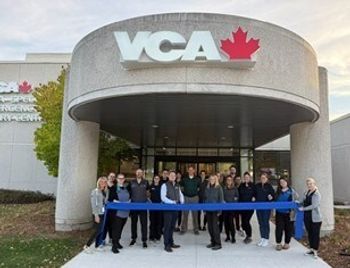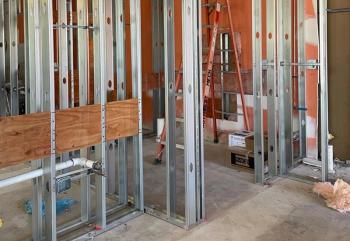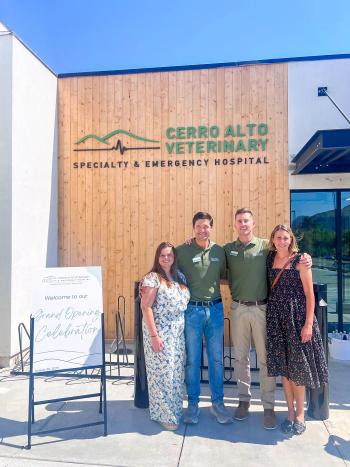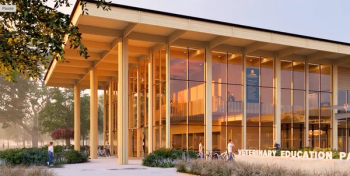
No more cramped quarters
Consulting with clients over a picnic table, housing patients in the restroom, and stacking portable cages to the ceiling may sound like a bad dream to most veterinarians. Dr. Neil Shaw and his team endured this daily reality for more than two years at Florida Veterinary Specialists, a 1,500-square-foot leasehold hospital in Tampa, Fla.
By Carolyn Chapman
Special assignments editor
Consulting with clients over a picnic table, housing patients in the restroom, and stacking portable cages to the ceiling may sound like a bad dream to most veterinarians. Dr. Neil Shaw and his team endured this daily reality for more than two years at Florida Veterinary Specialists, a 1,500-square-foot leasehold hospital in Tampa, Fla.
To end the nightmare, owner Dr. Shaw built a state-of-the-art 11,575-square-foot facility that accommodates 15 full-time and four part-time veterinarians and 60 staff members. The hospital focuses exclusively on referral specialty, emergency, and critical care cases and offers expertise in internal medicine, surgery, oncology, dermatology, critical care, and emergency care. The facility also houses a full-service diagnostic lab.
The judges of Veterinary Economics' 2000 Hospital Design Competition commented on the glass-enclosed ICU, the linear accelerator, the beautiful reception area, and the two radiology and surgery suites. "Wow," remarked one judge. "This practice exudes quality."
Specialty sprawl
Dr. Shaw opened Florida Veterinary Specialists the day after he completed his internal medicine residency at the University of Florida in 1996. Although he knew his hometown pets needed specialty care, he never expected such rapid growth--several hundred percent annually. His staff of one receptionist and one technician soon grew to 14 doctors and nearly 50 support staff members--and the facility was bursting at the seams.
After just eight months in the leasehold, Dr. Shaw decided to build a hospital. In the meantime, he needed to find more space. So Dr. Shaw arranged with the accountant next door to knock down a wall, convert his kitchen into a surgical supply room, and pay an exorbitant $5,000 to sublet the 6-by-8-foot room for one year.
As the business grew, Dr. Shaw added a bookkeeper and rented office space for her from a company a few doors down. Before long, the team was piling old radiographs and supplies in her office. So Dr. Shaw rented an air-conditioned storage space two miles away for fluids, catheters, medication, and cleaning supplies. "A staff member made daily trips to gather supplies," Dr. Shaw recalls.
When the landlord complained that Dr. Shaw's clients monopolized too many parking spaces, he rented slots from a church across the street. And with only two exam rooms, the 14 doctors often reserved the picnic table for consultations. For serious discussions, they'd sit in clients' cars.
In a desperate attempt to ease the space problem, Dr. Shaw convinced the accountant next door to move to a new office in the complex. The practice used the rest of his 800-square-foot suite to house an office, a third exam room, a break room, and an additional storage room. Dr. Shaw paid the accountant an additional $5,000 to sublet the space. He covered all the accountant's moving costs as well, including new stationery and utility hookups. When his team moved to the new facility, Dr. Shaw paid for the accountant to move back.
Ten times bigger
Dr. Shaw asked Darryl Shaw, his brother and hospital administrator, to oversee the project. Darryl Shaw wanted a site with easy access to main roads and high visibility for nighttime emergencies. He teamed with a land developer to get a prime two-acre corner spot. Before Dr. Shaw bought the site, the developer insisted on a design/build arrangement.
To gain expertise in veterinary hospital design, Dr. Shaw hired Gates, Hafen, Cochrane Architects. The firm mapped out an efficient floor plan based on a footprint of the building's shape. "Their insight into a project of this scale was worth the extra cost," Darryl Shaw says.
Dr. Shaw originally planned a 5,000-square-foot facility, but after a year he doubled his demands. "We wanted the facility to be big enough to handle growth, but not so big that it posed a financial risk," Darryl Shaw says. Still not satisfied, Dr. Shaw purchased an additional 4,000 square feet of land for expansion--which they're already planning to use.
Unconventional design
The long beige building features one main entrance for clients and a smaller staff entrance. In the reception area, granite countertops and Italian ceramic tile lend an air of quality and durability. Extensive use of interior glass helps the facility feel open.
Doctors use the seven exam rooms mainly for consultations, so the single doors aren't a problem. Most patient work occurs in the large treatment room, the two surgery suites, or the two radiology rooms. The all-glass ICU houses up to 14 critically ill animals, and the ward accommodates 50 animals. To help team members stabilize critical patients quickly, Dr. Shaw requested a triage room close to the exam rooms that contains a wet sink, an exam table, and ceiling oxygen and evacuation outlets.
Dr. Shaw had to choose which special procedures got designated spaces. Veterinarians perform ultrasonography and endoscopy in the treatment area. But the linear accelerator--one of about seven used exclusively for veterinary patients in private practice in the United States--required a special 800-square-foot room with five-foot-thick concrete walls. To offer I-131 therapy for cats with hyperthyroidism, Dr. Shaw added a separate room with thick walls and its own entrance. To avoid adding more space, Dr. Shaw negotiated with a local company to locate a mobile CT scanner adjacent to the facility permanently.
Referral clinics need strong relationships with area practitioners, so Dr. Shaw added a large conference room where a specialist presents a monthly CE seminar for area veterinarians. Staff doctors use the space to hold regular technician-training seminars. "Ongoing training and community outreach are critical to our continued success," Darryl Shaw emphasizes.
He believes specialty practices will continue to grow as clients become used to receiving specialty care and want the same service for their four-legged family members. The campers parked out front prove his point. Clients visit from as far away as Cape Cod, Mass. "We never could've handled that kind of traffic before," he says. "Our team members are proud to work in a hospital that reflects the quality of service we offer."
Carolyn Chapman, a former Veterinary Economics associate editor, is a freelance writer in Liberty, Mo.
July 2000 Veterinary Economics
Newsletter
From exam room tips to practice management insights, get trusted veterinary news delivered straight to your inbox—subscribe to dvm360.






